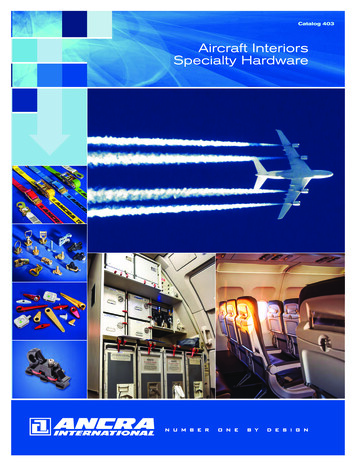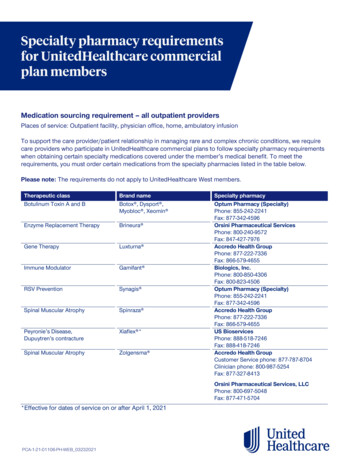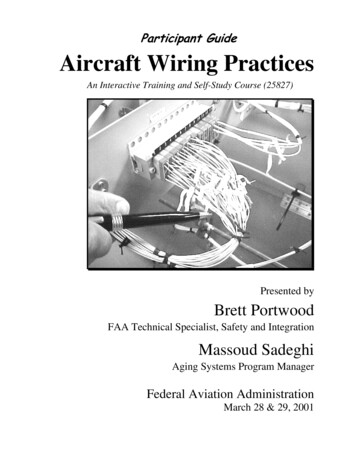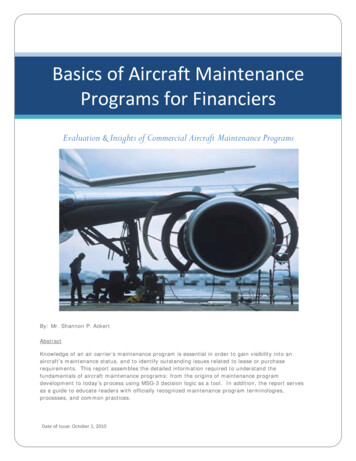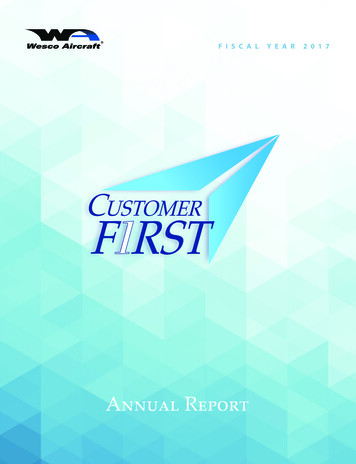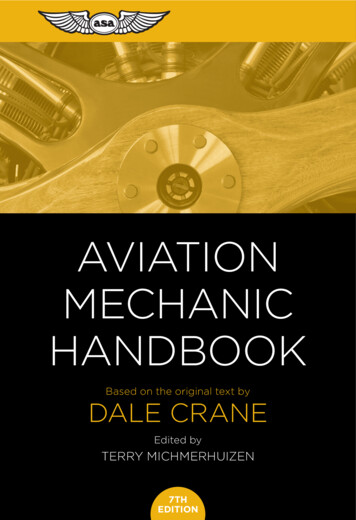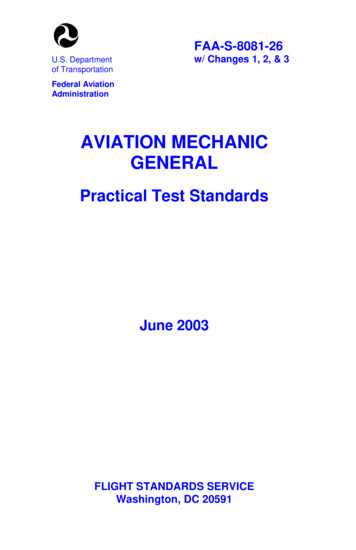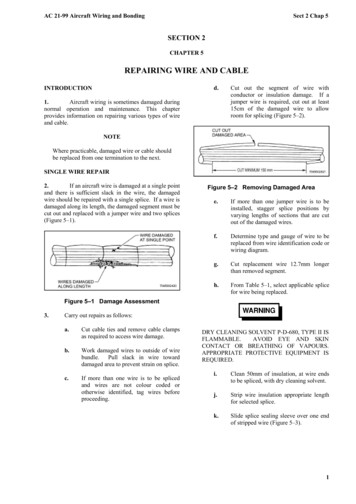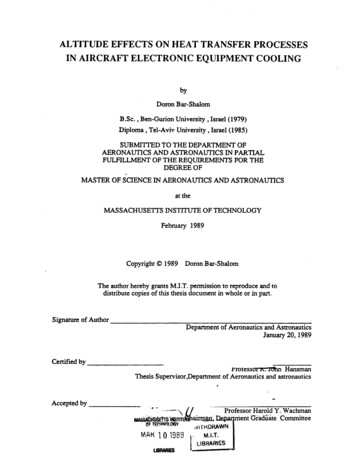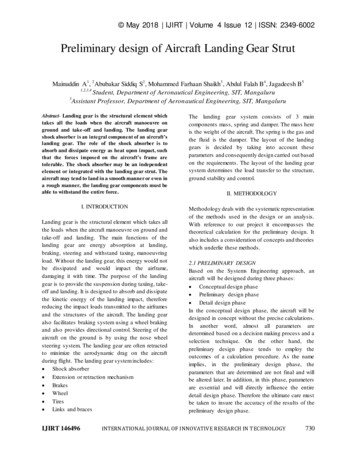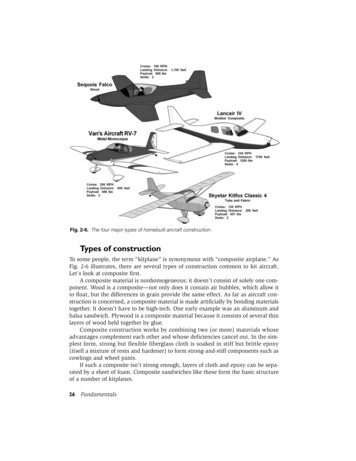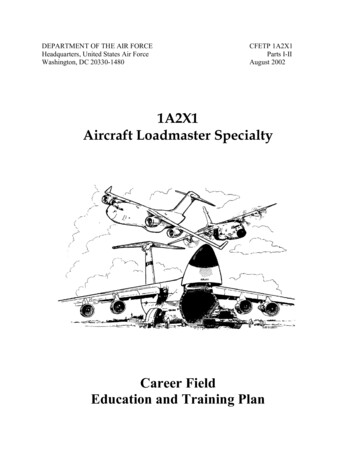
Transcription
DEPARTMENT OF THE AIR FORCEHeadquarters, United States Air ForceWashington, DC 20330-1480CFETP 1A2X1Parts I-IIAugust 20021A2X1Aircraft Loadmaster SpecialtyCareer FieldEducation and Training Plan
CAREER FIELD EDUCATION AND TRAINING PLANAIRCRAFT LOADMASTER SPECIALTYAFSC 1A2X1Table of ContentsPART IPrefaceAbbreviations/Terms Explained34Section A - General InformationPurpose of the CFETPUse of the CFETPCoordination and Approval of the CFETP6Section B - Career Progression and InformationSpecialty DescriptionSkill/Career ProgressionApprentice (3) LevelJourneyman (5) LevelCraftsman (7) LevelSuperintendent (9) LevelTraining DecisionsCommunity College of the Air ForceCareer Field Flow ChartsAssignment Locations7Section C - Skill Level Training RequirementsPurposeSpecialty DescriptionApprentice (3) LevelJourneyman (5) LevelCraftsman (7) LevelSuperintendent (9) Level16Section D - Resource Constraints19PART IISection A - Specialty Training Standard20Section B - Course Objective List26Section C - Support Materials28Section D - Training Course Index28Section E - MAJCOM Unique Requirements30Section F - MAJCOM Unique Resource Requirements31Supersedes: CFETP 1A2X1, Dated November 2001OPR: HQ USAF/XOOT (CMSgt Robert C. Shannon)Approved by: Colonel James J. BrooksNumber of Pages: 32
AIRCRAFT LOADMASTER SPECIALTYAFSC 1A2X1CAREER FIELD EDUCATION AND TRAINING PLANPart IPreface1. This Career Field Education and Training Plan (CFETP) is a comprehensive education andtraining document that identifies life-cycle education and training requirements, trainingsupport resources, and minimum core task requirements for this specialty. The CFETP willprovide personnel a clear career path to success and instills rigor in all aspects of career fieldtraining.2. The CFETP consists of two parts. Supervisors use both parts to plan, manage, and controltraining within the career field.2.1. Part I provides information necessary for overall management of the specialty. Section Aexplains how to use the plan; Section B identifies career progression information, duties andresponsibilities, training strategies, and career field path; Section C associates each level withspecialty qualifications (knowledge, education, training, and other); Section D indicatesresource constraints. Some examples are funds, manpower, equipment, and facilities. SectionE identifies transitional training guide requirements for SSgt through MSgt. Note: AFMAN 362108, Enlisted Classification, contains the specialty descriptions.2.2. Part II includes the following: Section A identifies the Specialty Training Standard (STS)and includes duties, tasks, and technical references to support training, Air Education andTraining Command (AETC) conducted training, wartime course, core tasks, andcorrespondence course requirements; Section B contains the course objective list and trainingstandards supervisors will use to determine if airmen satisfied training requirements; Section Cidentifies available support materials. An example is a qualification training package (QTP)which may be developed to support proficiency training. QTPs identified in this section havebeen developed to support upgrade/qualification training. These packages are identified inAFIND 8, Numerical Index of Specialized Educational Training Publications; Section D identifiesthe training course index. The course index lists mandatory and optional courses and is usedto determine resources available to support training; Section E identifies MAJCOM uniquetraining requirements.3. This CFETP is designed to ensure individuals in AFSC 1A2X1 receive comprehensive andeffective training at the appropriate phases of their career. This plan will enable us to traintoday’s work force for tomorrow’s jobs. At unit level, supervisors and trainers use Part II toidentify, plan, and conduct training commensurate with the overall goals of this plan.3
ABBREVIATIONS/TERMS EXPLAINEDAdvanced Training (AT). Formal course which provides individuals who are qualified in oneor more positions of their Air Force Specialty (AFS) with additional skills/knowledge to enhancetheir expertise in the career field. Training is for selected career airmen at the advanced levelof the AFS.Aircrew Training System (ATS). A system wherein a civilian contractor provides academic,simulator, and other designated aircrew training. ATS courses are listed in the applicable AFI11-2MDS-Specific, Volume 1.Air Force Career Field Manager (AFCFM). Individual appointed by Air Staff DCS’s to manageeducation, training, and resources for a specific career field(s).Basic Aircraft Qualification (BAQ). An aircrew member who has satisfactorily completedinitial qualification training and is qualified to perform aircrew duties in the unit aircraft. Themember must perform at the minimum frequency necessary to meet the most recent sortie andflight standards set for that weapon system in the applicable MDS-Specific, Volume 1.Basic Mission Capable (BMC). An aircrew member who has satisfactorily completed missionqualification training, does not maintain MR/CMR status, but maintains familiarization in thecommand or unit operational mission. The aircrew member may maintain qualification insome aspects of the unit mission, and is able to attain full qualification in the unit missionwithin 30 days, or otherwise specified in the applicable MDS-Specific, Volume 1.Career Development Course (CDC). A self-paced correspondence course designed to upgradea skill level.Combat Mission Ready (CMR). An aircrew member who has satisfactorily completed missionqualification training and maintains qualification and proficiency in the command or unitoperational mission.Core Task. Tasks the AFCFM identify as minimum qualification requirements within an AFSC,regardless of duty position. Core tasks may be specified for a particular skill level or in generalacross the AFSC. Guidance for using core tasks can be found in the applicable CFETPnarrative.Course Objective Lists (COL). A publication, derived from the initial skills course trainingstandard, that identifies the task and knowledge requirements, and respective standardsprovided to achieve a 3-skill level in this career field. Supervisors use the COL to conductgraduate evaluations in accordance with AFI 36-2201, Developing, Managing, and ConductingMilitary Training Programs.Cockpit/Crew Resource Management (CRM). The effective use of all available resources—people, weapon systems, facilities and equipment, and environment—by individuals or crews tosafely and efficiently accomplish an assigned mission or task. The term “CRM” will be used torefer to the training program, objectives, and key skills directed to this end. MAJCOMs mayimplement their programs as either “cockpit” or “crew” resource management based on theirrespective missions.Enlisted Specialty Training (EST). A mix of formal training (technical school) and informaltraining (on-the-job) to qualify and upgrade airmen in each specialty skill level.Exportable Training. Additional training via computer assisted, paper text, interactive video,or other necessary means to supplement training.Initial Skills Training. A formal school course that results in an award of a 3-skill level AFSC.4
Instructional System Development (ISD). A deliberate and orderly, but flexible process forplanning, developing, validating, implementing, and reviewing instructional programs. Itensures personnel are taught, in a cost efficient way, the knowledge and skills for successfuljob performance.MAJCOM/FOA EEFI. Major Command/Field Operating Agency Essential Elements of FriendlyInformation. Unclassified information that when combined with other information can revealan insight into classified operations.Mission Design Series (MDS). A term used to identify an aircraft, i.e., C-5, C-130, C-17, C141Mission Ready/Combat Mission Ready (MR/CMR). An aircrew member who hassatisfactorily completed mission qualification training and maintains qualification andproficiency in the command or unit operational mission.On-the-Job Training (OJT). Hands-on, over-the-shoulder training conducted to certifypersonnel in both upgrade (skill level award) and job qualification (duty position certification)training.Phase I Initial Qualification Training (IQT). An aircrew member engaged in training neededto qualify for basic aircrew duties in an assigned position for a specific aircraft, without regardfor the unit’s operational mission.Phase II Mission Qualification Training (MQT). An aircrew member engaged in trainingneeded to qualify in an assigned aircrew position to perform the command or unit operationalmission.Phase III Continuation Training (CT). An aircrew member engaged in training to maintainand develop a qualification required in Phase I or Phase II training. An aircrew member inPhase III training may be assigned Mission Ready (MR), Mission Capable (MC), or BasicQualification (BQ) status.Qualification Training Package (QTP). An instructional course designed for use at the unit toqualify, or aid qualification, in a duty position or program, or on a piece of equipment. It maybe printed, computer based, or in other audiovisual media.Resource Constraints. Resource deficiencies, such as money, facilities, time, manpower, andequipment that preclude desired training from being delivered.Specialty Training Standard (STS). An Air Force publication that describes skills andknowledge that airman in a particular Air Force specialty need on the job, and identifies thetraining provided to achieve a 3-, 5-, and 7-skill level within an enlisted AFS. It also serves asa contract between AETC and the functional user to show which training requirements for anAFSC are taught in formal schools and correspondence courses.Standard. An exact value, a physical entity, or abstract concept, that the appropriateauthority, custom, or common consent sets up and defines to serve as a reference, model, orrule in measuring quantities or qualities, developing practices or procedures, or evaluatingresults. A fixed quantity or quality.Total Force. The collective components (active, reserve, guard, and civilian elements) of theUnited States Air Force.Upgrade Training (UGT). Training that leads to the award of a higher skill level in an AFS.5
Section A - General Information1. Purpose. This CFETP provides information necessary for the Air Force Career FieldManager (AFCFM), MAJCOM functional managers (MFMs), commanders, training managers,supervisors, and trainers to plan, develop, manage, and conduct an effective and efficientcareer field training program. The plan outlines the training that individuals must receive inorder to develop and progress throughout their career. For the purpose of this plan, training isdivided into four areas: initial skills, upgrade training (UGT), qualification training (QT), andcontinuation training (CT). Initial skills training is the Air Force Specialty specific training anindividual receives upon entry into the Air Force or upon retraining into this specialty foraward of the 3-skill level. Upgrade training identifies the mandatory courses, task qualificationrequirements, and correspondence course completion required for award of the 3-, 5-, 7-, and9-skill levels. Qualification training is actual hands-on task performance training designed toqualify an airman in a specific duty position. This training program occurs both during andafter the upgrade training process. It is designed to provide the performance skills/knowledgetraining required for the job. Continuation training is additional training either in-residence orexportable advanced training courses, or on-the-job training, provided to personnel to increasetheir skills and knowledge beyond the minimum required. The CFETP has several purposes,some are:1.1. Serves as a management tool to plan, manage, conduct, and evaluate a career fieldtraining program. Also, it is used to help supervisors identify training at the appropriate pointin an individual’s career.1.2. Identifies task and knowledge training requirements and recommends education andtraining for each skill level and phase of an individual’s career in this AFS.1.3. Lists training courses available in the specialty, identifies sources of training, and thetraining medium.1.4. Identifies major resource constraints that impact full implementation of the desired careerfield training program.2. Uses. The plan will be used by MFMs and supervisors at all levels to ensurecomprehensive and cohesive training programs are available and/or instituted for eachindividual in the specialty.2.1. AETC training personnel will develop/revise formal resident, non-resident, field andexportable training based on requirements established by the user and documented in Part IIof the CFETP. They will also work with the AFCFM to develop acquisition strategies forobtaining resources needed to provide the identified training.2.2. MFMs will ensure their training programs complement the CFETP mandatory initial andupgrade skills requirements. OJT, resident training, contract training, or exportable coursescan satisfy identified requirements. MAJCOM-developed training to support this AFSC mustbe identified for inclusion in this plan and must not duplicate available training resources.2.3. Each individual will complete the mandatory training requirements specified in this plan.The list of courses in Part II will be used as a reference to support training.2.4. AETC, MAJCOM functional managers, and/or unit training managers developQualification training packages (QTP). Unit developed QTPs will be provided to the parentMAJCOM and included in the CFETP.2.5. Personnel in AFSC 1AXXX are exempt from maintaining OJT Training Folders (AF Form623). All core tasks identified in this document are satisfied in IQT, MQT, and CT. Trainedinstructors and evaluators certify this training via AF Form 8. Certification of the Form 8eliminates the requirement to document STS items in this CFETP.6
3. Coordination and Approval. The AFCFM is approval authority. MAJCOM representativesand AETC training personnel will identify and coordinate on the career field trainingrequirements. The AETC training manager for this specialty will initiate an annual review ofthis document by AETC and MFMs to ensure currency and accuracy. Using the list of coursesin Part II, they will eliminate duplicate training. Applicable inputs/changes to this CFETP willbe routed to the. AETC/DOFM, 1F Street, Ste. 2, Randolph AFB, TX 78150-4325.Section B - Career Progression and Information4. Specialty Description.4.1. Specialty Summary. Accomplish preflight and postflight of aircraft and aircraft systems.Receives cargo/passenger load briefings, checks placement of cargo/passengers againstaircraft limitations/restrictions, determines adequacy of cargo documentation. If required, loadplans cargo/passenger loads. Supervises cargo/passenger loading and offloading activities.Determines cargo placement and restraint requirements and directs and checks the placementof restraint equipment. Computes aircraft weight and balance. Demonstrates use of lifesupport equipment. Accomplishes passenger comfort activities during flight. Performs aircrewfunctions and other mission specific qualification duties to include the airdrop ofpersonnel/equipment.4.2. Duties and Responsibilities.4.2.1. Receives cargo/passenger load briefing and reviews load plan and cargo documentation.Accomplishes load planning of cargo/passenger loads if required. Reviews aircraft forms forcondition of aircraft. Accomplishes preflight inspection of aerospace ground equipment andapplies external power to the aircraft. Operates aircraft radio systems. Accomplishes pre-flightinspection of the aircraft and cargo/airdrop systems according to flight manual procedures.4.2.2. Supervises cargo/passenger loading and off-loading operations. Directs the placementof material handling equipment to accomplish cargo on/off loading operations. Operates theaircraft winch to on/offload cargo. Ensures cargo/passengers are placed according to loadplans. Determines cargo restrains requirements according to criteria and directs and checksthe application of cargo restraint equipment. Checks cargo/passenger loads against manifests.4.2.3. Ensures availability of fleet service equipment and passenger comfort items. Receives,receipts for and stows in-flight meals. Accomplishes passenger briefings to include the use ofemergency equipment, evacuation procedures, and border clearance requirements.Demonstrates the use of passenger emergency oxygen systems and life vests. Computes andcompletes aircraft weight and balance documentation.4.2.4. Accomplishes in-flight checks according to flight manual procedures. Monitors cargoand provides for passenger comfort. Prepares and dispenses passenger meals, snacks andrefreshments. Completes required aircraft forms documentation and border clearancerequirements.5. Skill/Career Progression. Adequate training and timely progression from the apprenticeto the superintendent skill level play an extremely important role in the Air Force's ability toaccomplish its mission. Therefore, it is essential that everyone involved in training do theirpart to plan, develop, manage, conduct and evaluate an effective and efficient training program.The guidance provided in this part of the CFETP will ensure individuals receive viable trainingat appropriate points in their career. The following narrative and the AFSC 1A2X1 career fieldflow charts identify the training career path. They define the training required in anindividual's career.7
5.1. Apprentice (3) Level. Initial skills training in the aircraft loadmaster specialty consist ofthe task and knowledge training provided in the resident apprentice aircraft loadmaster courselisted in the formal schools catalog. Task and knowledge training requirements are identifiedin STS 1A2X1, which is included in Part II, Section A, of this plan. In order to be awardedAFSC 1A231, an individual must complete the Apprentice Aircraft Loadmaster Course.5.2. Journeyman (5) Level. To be awarded AFSC 1A251, an individual must complete allmission ready training as indicated by the master task listing/objective hierarchy that isapplicable to the trainee's weapon system assignment and complete the 5-skill level CareerDevelopment Course (CDC). Additionally, the trainee must meet all requirements prescribed inthe applicable MAJCOM aircrew training directives. Individuals will use their CDCs to preparefor promotion testing under the Weighted Airman Promotion System (WAPS). They shouldconsider continuing their education towards a Community College of the Air Force (CCAF)degree.5.3. Craftsman (7) Level. To be awarded AFSC 1A271, an individual must be a SSgt, completeall 3- and 5-skill level training requirements and complete training requirements listed in theapplicable MAJCOM aircrew training directives. Qualification training is utilized based on theindividual's training needs. Continuation training is available, but not limited to the traininglisted in Part II, Section E, of this plan.5.4. Superintendent (9) Level. To be awarded AFSC 1A291, an individual must be a SMSgtand complete any other requirements specified in AFMAN 36-2108, Military ClassificationGuidance.6. Training Decisions. The CFETP uses a building block approach (simple to complex) toencompass the entire spectrum of training requirements for the Aircraft Loadmaster careerfield. This CFETP was developed to include life-cycle (day one through retirement) trainingrequirements for this specialty. The spectrum includes a strategy for when, where, and how tomeet the training requirements. The strategy must be apparent and affordable to reduceduplication of training and eliminate a disjointed approach to training. The following trainingdecisions were made at the career field Utilization and Training Workshop held at Scott AFB ,19-21 Feb 2002.6.1. Initial Skills Training. IAW AFMAN 36-2108, A
2108, Enlisted Classification, contains the specialty descriptions. 2.2. Part II includes the following: Section A identifies the Specialty Training Standard (STS) and includes duties, tasks, and technical references to support training, Air Education and Training Command (AETC) conducted t
